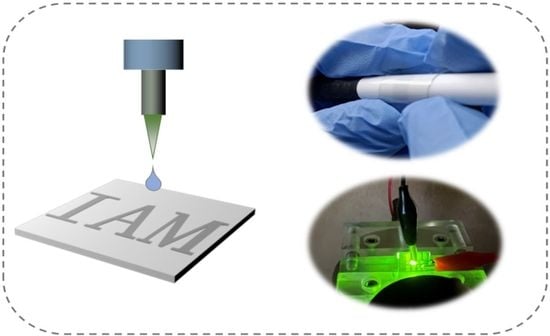Inkjet-Printed Highly Conductive Poly(3,4-ethylenedioxythiophene): Poly(styrenesulfonate) Electrode for Organic Light-Emitting Diodes
Abstract
:1. Introduction
2. Materials and Methods
2.1. Materials
2.2. Preparation of High Conductive PEDOT:PSS Ink and Light-Emitting Solution
2.3. Inkjet Printing and Characterization of the PEDOT:PSS Film
2.4. Fabrication and Characterization of OLEDs
3. Results and Discussion
4. Conclusions
Author Contributions
Funding
Conflicts of Interest
References
- Aizawa, N.; Pu, Y.J.; Watanabe, M.; Chiba, T.; Ideta, K.; Toyota, N.; Igarashi, M.; Suzuri, Y.; Sasabe, H.; Kido, J. Solution-processed multilayer small-molecule light-emitting devices with high-efficiency white-light emission. Nat. Commun. 2014, 5, 5756. [Google Scholar] [CrossRef] [PubMed]
- Han, T.-H.; Lee, Y.; Choi, M.-R.; Woo, S.-H.; Bae, S.-H.; Hong, B.H.; Ahn, J.-H.; Lee, T.-W. Extremely efficient flexible organic light-emitting diodes with modified graphene anode. Nat. Photonics 2012, 6, 105–110. [Google Scholar] [CrossRef]
- Li, N.; Oida, S.; Tulevski, G.S.; Han, S.J.; Hannon, J.B.; Sadana, D.K.; Chen, T.C. Efficient and bright organic light-emitting diodes on single-layer graphene electrodes. Nat. Commun. 2013, 4, 2294. [Google Scholar] [CrossRef]
- Ou, Q.-D.; Zhou, L.; Li, Y.-Q.; Shen, S.; Chen, J.-D.; Li, C.; Wang, Q.-K.; Lee, S.-T.; Tang, J.-X. Extremely Efficient White Organic Light-Emitting Diodes for General Lighting. Adv. Funct. Mater. 2014, 24, 7249–7256. [Google Scholar] [CrossRef]
- Wang, Z.B.; Helander, M.G.; Qiu, J.; Puzzo, D.P.; Greiner, M.T.; Hudson, Z.M.; Wang, S.; Liu, Z.W.; Lu, Z.H. Unlocking the full potential of organic light-emitting diodes on flexible plastic. Nat. Photonics 2011, 5, 753–757. [Google Scholar] [CrossRef]
- Song, W.; Fanady, B.; Peng, R.; Hong, L.; Wu, L.; Zhang, W.; Yan, T.; Wu, T.; Chen, S.; Ge, Z. Foldable Semitransparent Organic Solar Cells for Photovoltaic and Photosynthesis. Adv. Energy Mater. 2020, 10, 2000136. [Google Scholar] [CrossRef]
- Chou, W.-Y.; Lin, S.-T.; Cheng, H.-L.; Chang, M.-H.; Guo, H.-R.; Wen, T.-C.; Mai, Y.-S.; Horng, J.-B.; Kuo, C.-W.; Tang, F.-C.; et al. Polymer light-emitting diodes with thermal inkjet printed poly(3,4-ethylenedioxythiophene):polystyrenesulfonate as transparent anode. Thin Solid Films 2007, 515, 3718–3723. [Google Scholar] [CrossRef]
- Yoon, S.; Sohn, S.; Kwon, J.; Park, J.A.; Jung, S. Double-shot inkjet printing for high-conductivity polymer electrode. Thin Solid Films 2016, 607, 55–58. [Google Scholar] [CrossRef]
- Wang, T.; Lu, K.; Xu, Z.; Lin, Z.; Ning, H.; Qiu, T.; Yang, Z.; Zheng, H.; Yao, R.; Peng, J. Recent Developments in Flexible Transparent Electrode. Crystals 2021, 11, 511. [Google Scholar] [CrossRef]
- Du, H.; Guo, Y.; Cui, D.; Li, S.; Wang, W.; Liu, Y.; Yao, Y.; Zhao, L.; Dong, X. Solution-processed PEDOT:PSS:GO/Ag NWs composite electrode for flexible organic light-emitting diodes. Spectrochim. Acta. A Mol. Biomol. Spectrosc. 2021, 248, 119267. [Google Scholar] [CrossRef] [PubMed]
- Lee, J.; Han, T.H.; Park, M.H.; Jung, D.Y.; Seo, J.; Seo, H.K.; Cho, H.; Kim, E.; Chung, J.; Choi, S.Y.; et al. Synergetic electrode architecture for efficient graphene-based flexible organic light-emitting diodes. Nat. Commun. 2016, 7, 11791. [Google Scholar] [CrossRef] [Green Version]
- Tao, F.; Liu, Y.; Ren, X.; Jiang, A.; Wei, H.; Zhai, X.; Wang, F.; Stock, H.-R.; Wen, S.; Ren, F. Carbon nanotube-based nanomaterials for high-performance sodium-ion batteries: Recent advances and perspectives. J. Alloys Compd. 2021, 873, 159742. [Google Scholar] [CrossRef]
- Liu, L.; Li, S.; Wu, L.; Chen, D.; Cao, K.; Duan, Y.; Chen, S. Enhanced flexibility and stability of PEDOT:PSS electrodes through interfacial crosslinking for flexible organic light-emitting diodes. Org. Electron. 2021, 89, 106047. [Google Scholar] [CrossRef]
- Kommeren, S.; Coenen, M.J.J.; Eggenhuisen, T.M.; Slaats, T.W.L.; Gorter, H.; Groen, P. Combining solvents and surfactants for inkjet printing PEDOT:PSS on P3HT/PCBM in organic solar cells. Org. Electron. 2018, 61, 282–288. [Google Scholar] [CrossRef] [Green Version]
- Ely, F.; Avellaneda, C.O.; Paredez, P.; Nogueira, V.C.; Santos, T.E.A.; Mammana, V.P.; Molina, C.; Brug, J.; Gibson, G.; Zhao, L. Patterning quality control of inkjet printed PEDOT:PSS films by wetting properties. Synth. Met. 2011, 161, 2129–2134. [Google Scholar] [CrossRef]
- Darwis, D.; Sesa, E.; Elkington, D.; Sharafutdinova, G.; Lewis, T.; Zhou, X.; Dastoor, P.C.; Belcher, W.J. Printing of PEDOT:PSS for top gate organic thin film transistor. J. Phys. Conf. Ser. 2021, 1763, 012078. [Google Scholar] [CrossRef]
- Ahmed, A.; Jalil, M.A.; Hossain, M.M.; Moniruzzaman, M.; Adak, B.; Islam, M.T.; Parvez, M.S.; Mukhopadhyay, S. A PEDOT:PSS and graphene-clad smart textile-based wearable electronic Joule heater with high thermal stability. J. Mater. Chem. C 2020, 8, 16204–16215. [Google Scholar] [CrossRef]
- Griffin, J.; Ryan, A.J.; Lidzey, D.G. Solution modification of PEDOT:PSS inks for ultrasonic spray coating. Org. Electron. 2017, 41, 245–250. [Google Scholar] [CrossRef]
- Singh, A.; Katiyar, M.; Garg, A. Understanding the formation of PEDOT:PSS films by ink-jet printing for organic solar cell applications. RSC Adv. 2015, 5, 78677–78685. [Google Scholar] [CrossRef] [Green Version]
- Ritruksa, M.; Wongrerkdee, S.; Lohawet, K.; Kaewprajak, A.; Kumnorkaew, P.; Wongrerkdee, S. Surface modification of PEDOT: PSS film by chemical vapor texturing process for enhanced organic photovoltaics. Surf. Interfaces 2020, 21, 100716. [Google Scholar] [CrossRef]
- Lin, T.; Sun, X.; Hu, Y.; Mu, W.; Sun, Y.; Zhang, D.; Su, Z.; Chu, B.; Cui, Z. Blended host ink for solution processing high performance phosphorescent OLEDs. Sci. Rep. 2019, 9, 6845. [Google Scholar] [CrossRef] [PubMed] [Green Version]
- Derby, B. Inkjet Printing of Functional and Structural Materials: Fluid Property Requirements, Feature Stability, and Resolution. Annu. Rev. Mater. Res. 2010, 40, 395–414. [Google Scholar] [CrossRef]
- Tait, J.G.; Witkowska, E.; Hirade, M.; Ke, T.-H.; Malinowski, P.E.; Steudel, S.; Adachi, C.; Heremans, P. Uniform Aerosol Jet printed polymer lines with 30μm width for 140ppi resolution RGB organic light emitting diodes. Org. Electron. 2015, 22, 40–43. [Google Scholar] [CrossRef]
- Zhu, H.; Shin, E.S.; Liu, A.; Ji, D.; Xu, Y.; Noh, Y.Y. Printable Semiconductors for Backplane TFTs of Flexible OLED Displays. Adv. Funct. Mater. 2019, 30, 1904588. [Google Scholar] [CrossRef]
- McKinley, G.H.; Renardy, M. Wolfgang von Ohnesorge. Phys. Fluids 2011, 23, 127101. [Google Scholar] [CrossRef] [Green Version]
- Krainer, S.; Smit, C.; Hirn, U. The effect of viscosity and surface tension on inkjet printed picoliter dots. RSC Adv. 2019, 9, 31708–31719. [Google Scholar] [CrossRef] [Green Version]
- Shin, P.; Sung, J.; Lee, M.H. Control of droplet formation for low viscosity fluid by double waveforms applied to a piezoelectric inkjet nozzle. Microelectron. Reliab. 2011, 51, 797–804. [Google Scholar] [CrossRef]
- Du, Z.; Zhou, H.; Yu, X.; Han, Y. Controlling the polarity and viscosity of small molecule ink to suppress the contact line receding and coffee ring effect during inkjet printing. Colloids Surf. A Physicochem. Eng. Asp. 2020, 602, 125111. [Google Scholar] [CrossRef]
- Amruth, C.; Szymanski, M.Z.; Luszczynska, B.; Ulanski, J. Inkjet Printing of Super Yellow: Ink Formulation, Film Optimization, OLEDs Fabrication, and Transient Electroluminescence. Sci. Rep. 2019, 9, 8493. [Google Scholar]
- Teo, M.Y.; RaviChandran, N.; Kim, N.; Kee, S.; Stuart, L.; Aw, K.C.; Stringer, J. Direct Patterning of Highly Conductive PEDOT:PSS/Ionic Liquid Hydrogel via Microreactive Inkjet Printing. ACS Appl. Mater. Interfaces 2019, 11, 37069–37076. [Google Scholar] [CrossRef] [PubMed]
- Mu, L.; Hu, Z.; Zhong, Z.; Jiang, C.; Wang, J.; Peng, J.; Cao, Y. Inkjet-printing line film with varied droplet-spacing. Org. Electron. 2017, 51, 308–313. [Google Scholar] [CrossRef]
- Basak, I.; Nowicki, G.; Ruttens, B.; Desta, D.; Prooth, J.; Jose, M.; Nagels, S.; Boyen, H.G.; D’Haen, J.; Buntinx, M.; et al. Inkjet Printing of PEDOT:PSS Based Conductive Patterns for 3D Forming Applications. Polymers 2020, 12, 2915. [Google Scholar] [CrossRef]
- Eom, S.H.; Senthilarasu, S.; Uthirakumar, P.; Yoon, S.C.; Lim, J.; Lee, C.; Lim, H.S.; Lee, J.; Lee, S.-H. Polymer solar cells based on inkjet-printed PEDOT:PSS layer. Org. Electron. 2009, 10, 536–542. [Google Scholar] [CrossRef]
- Sleczkowski, P.; Borkowski, M.; Zajaczkowska, H.; Ulanski, J.; Pisula, W.; Marszalek, T. Geometry Control of Source/Drain Electrodes in Organic Field-Effect Transistors by Electrohydrodynamic Inkjet Printing. Materials 2020, 13, 4974. [Google Scholar] [CrossRef] [PubMed]
- Lo, L.W.; Zhao, J.; Wan, H.; Wang, Y.; Chakrabartty, S.; Wang, C. An Inkjet-Printed PEDOT:PSS-Based Stretchable Conductor for Wearable Health Monitoring Device Applications. ACS Appl. Mater. Interfaces 2021, 13, 21693–21702. [Google Scholar] [CrossRef]
- Cai, M.; Ye, Z.; Xiao, T.; Liu, R.; Chen, Y.; Mayer, R.W.; Biswas, R.; Ho, K.M.; Shinar, R.; Shinar, J. Extremely efficient indium-tin-oxide-free green phosphorescent organic light-emitting diodes. Adv. Mater. 2012, 24, 4337–4342. [Google Scholar] [CrossRef] [PubMed]
- Meerheim, R.; Scholz, S.; Olthof, S.; Schwartz, G.; Reineke, S.; Walzer, K.; Leo, K. Influence of charge balance and exciton distribution on efficiency and lifetime of phosphorescent organic light-emitting devices. J. Appl. Phys. 2008, 104, 014510. [Google Scholar] [CrossRef]
- So, F.; Krummacher, B.; Mathai, M.K.; Poplavskyy, D.; Choulis, S.A.; Choong, V.-E. Recent progress in solution processable organic light emitting devices. J. Appl. Phys. 2007, 102, 091101. [Google Scholar] [CrossRef]
- Lee, T.-W.; Noh, T.; Shin, H.-W.; Kwon, O.; Park, J.-J.; Choi, B.-K.; Kim, M.-S.; Shin, D.W.; Kim, Y.-R. Characteristics of Solution-Processed Small-Molecule Organic Films and Light-Emitting Diodes Compared with their Vacuum-Deposited Counterparts. Adv. Funct. Mater. 2009, 19, 1625–1630. [Google Scholar] [CrossRef]
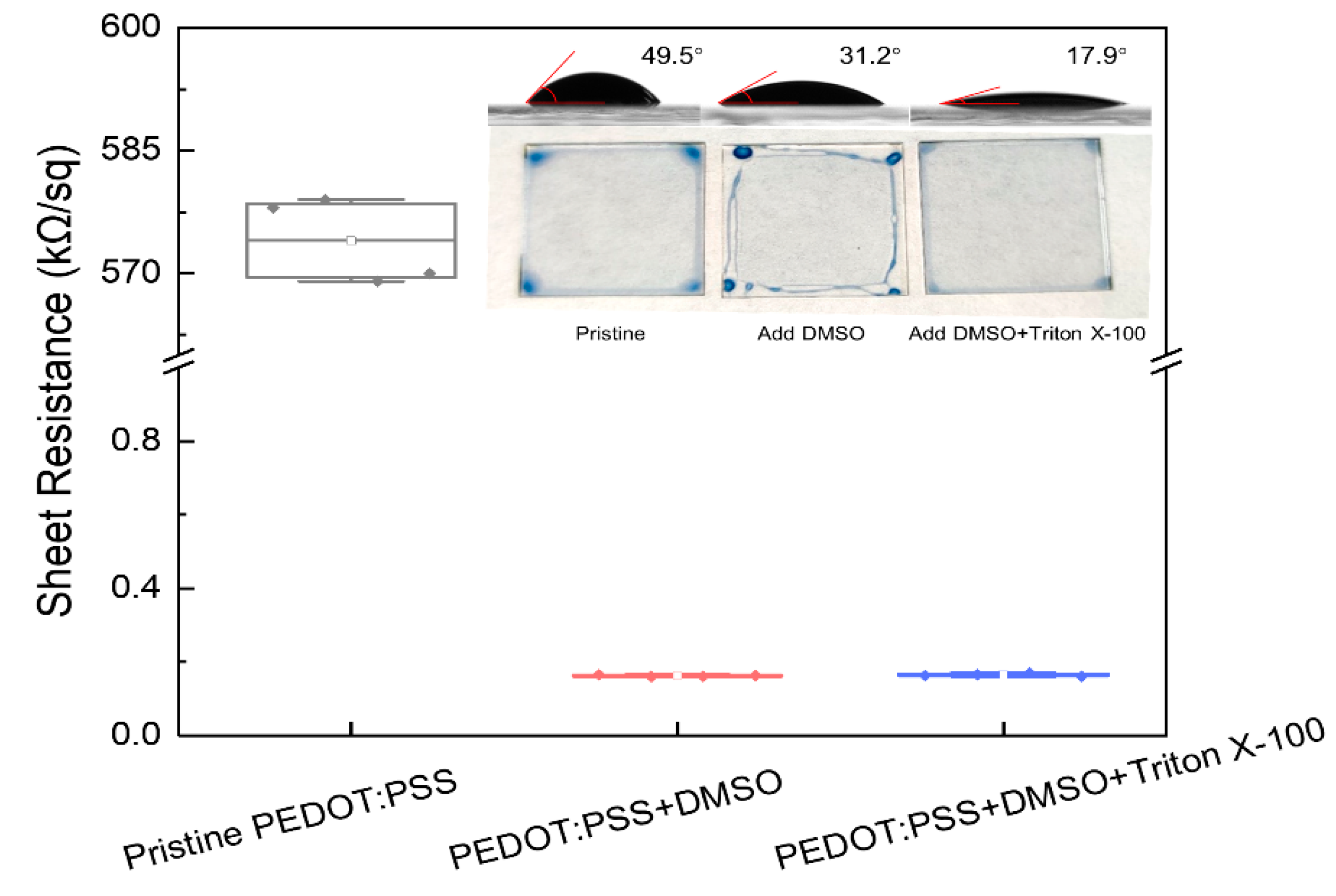

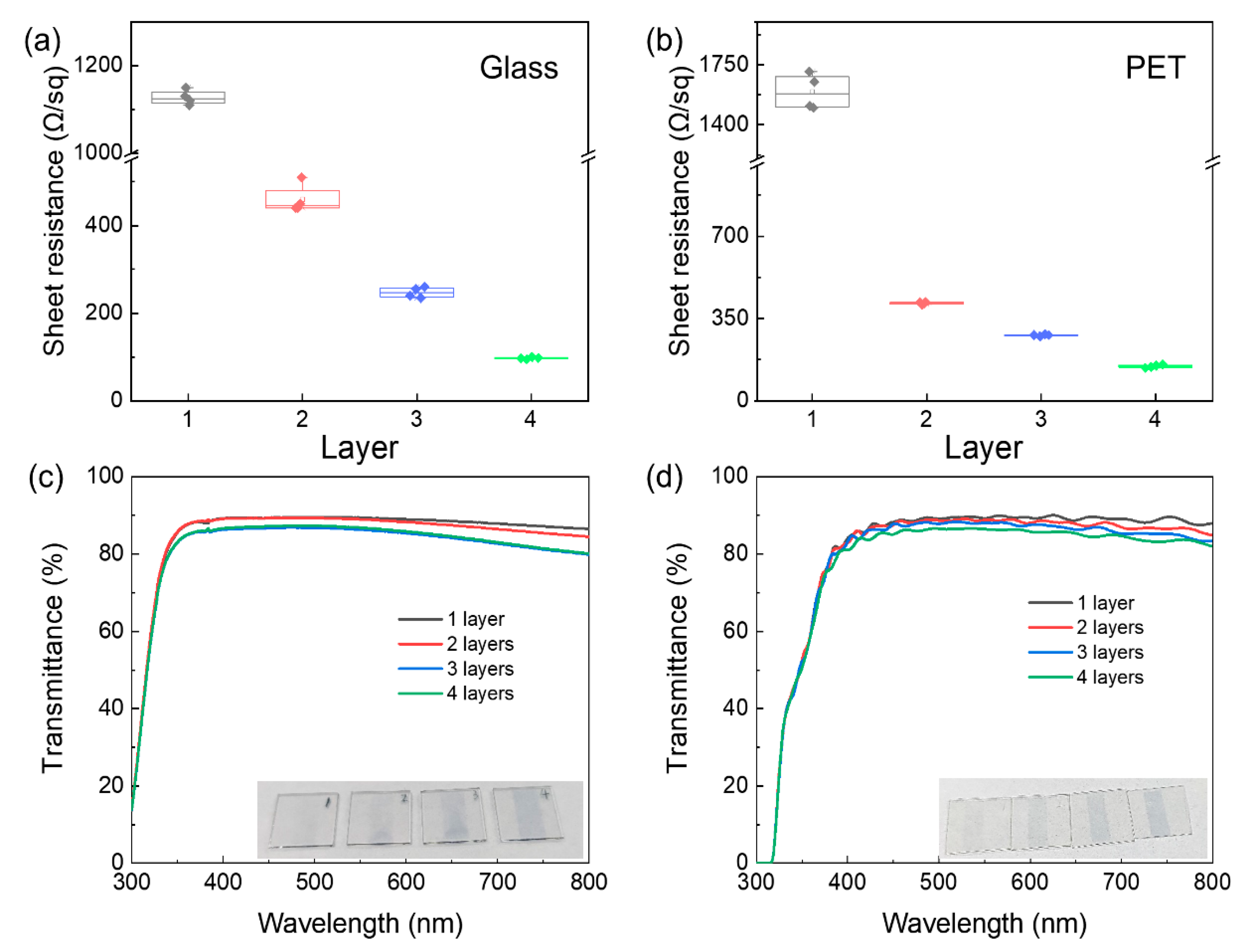
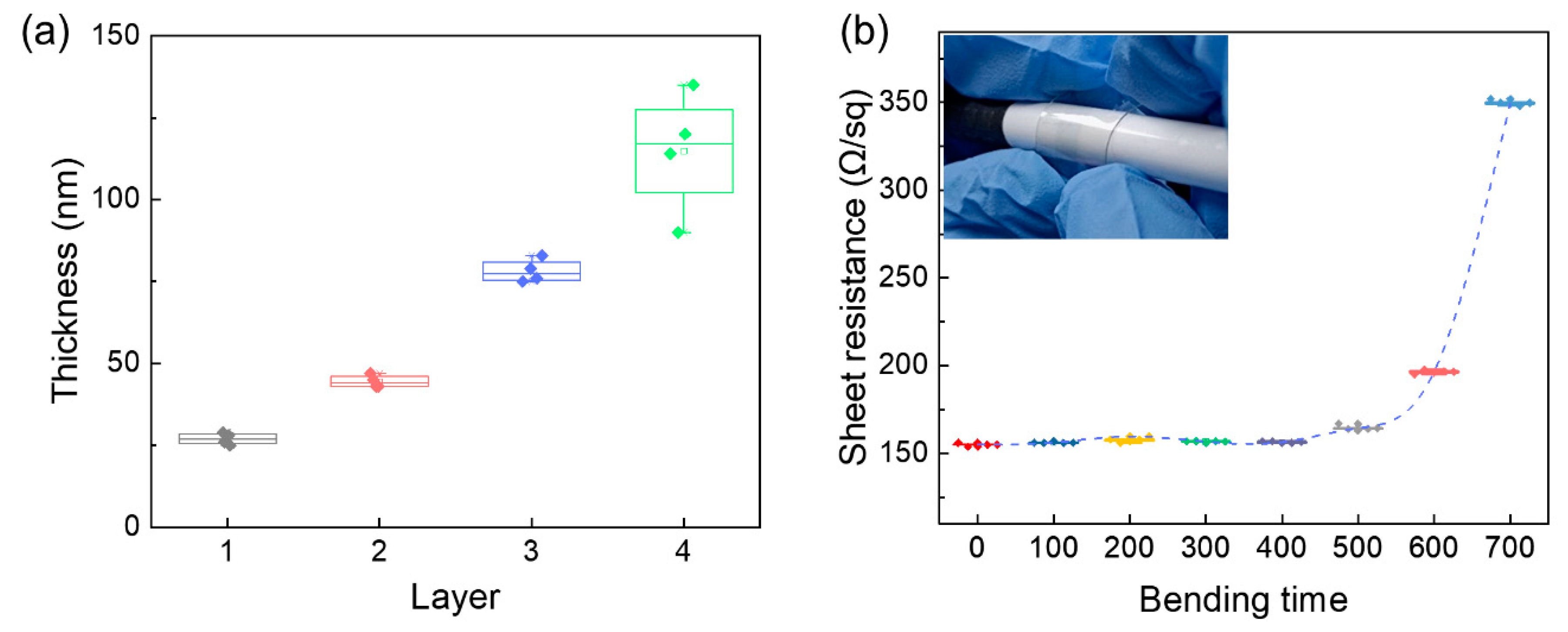
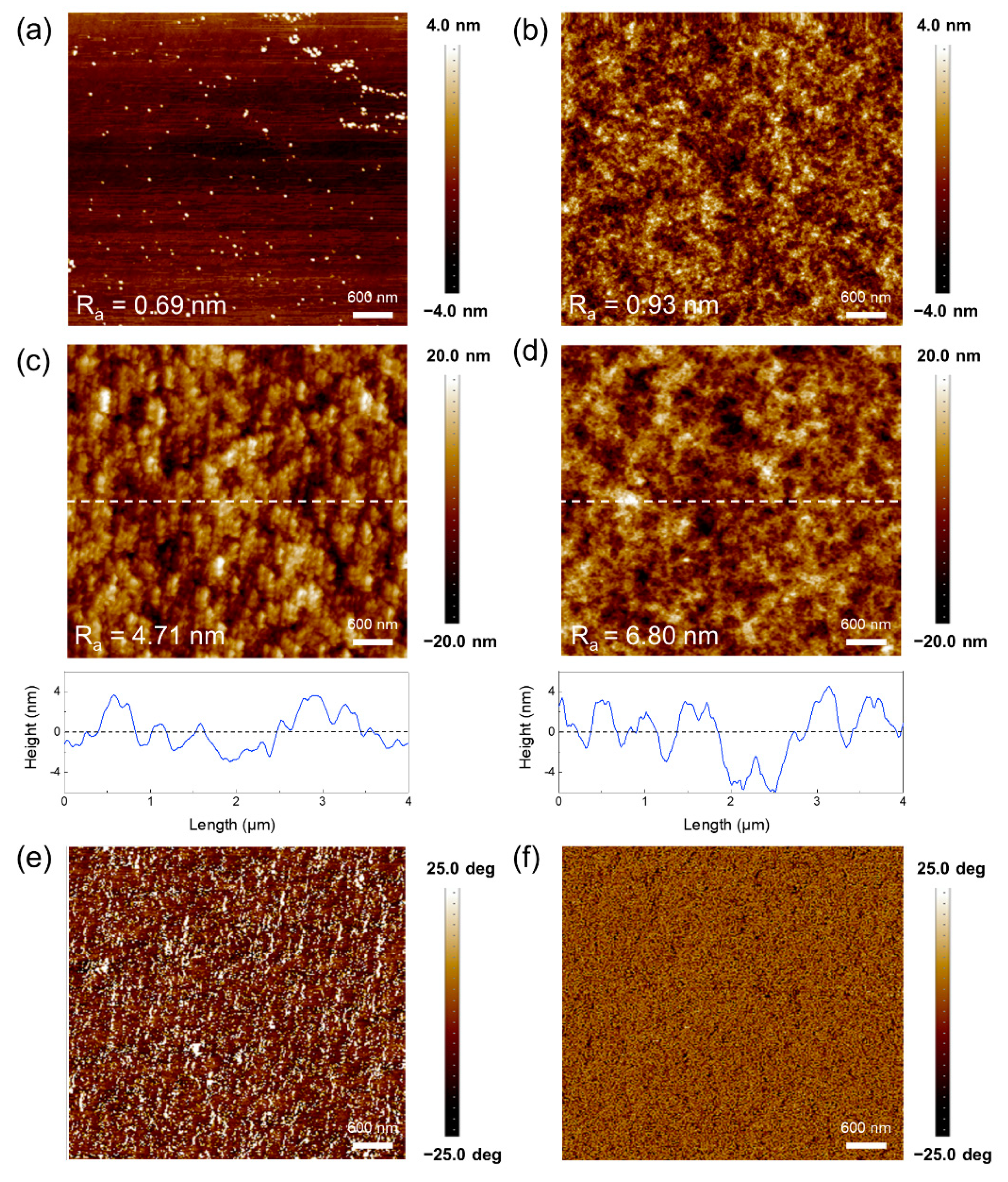
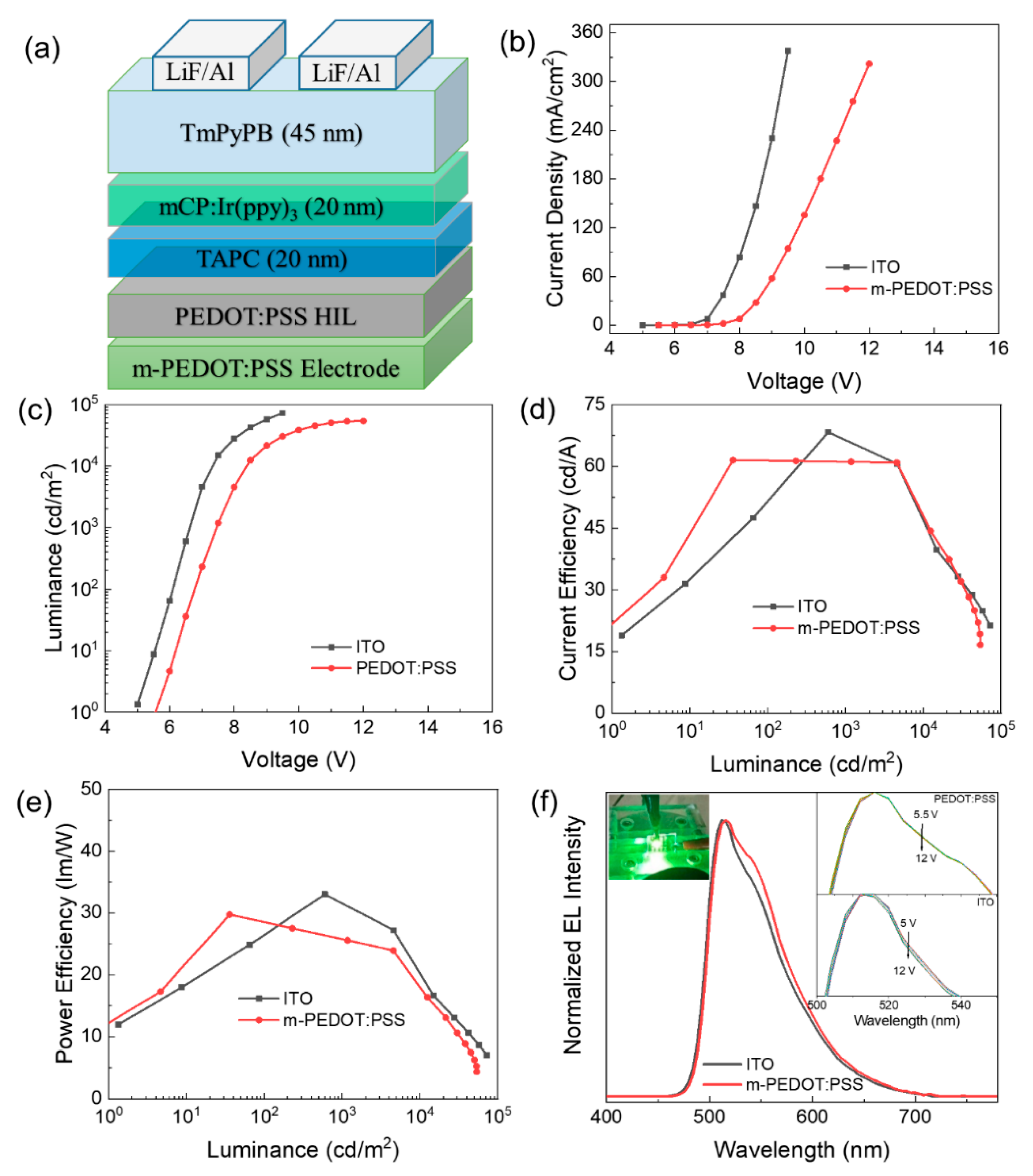
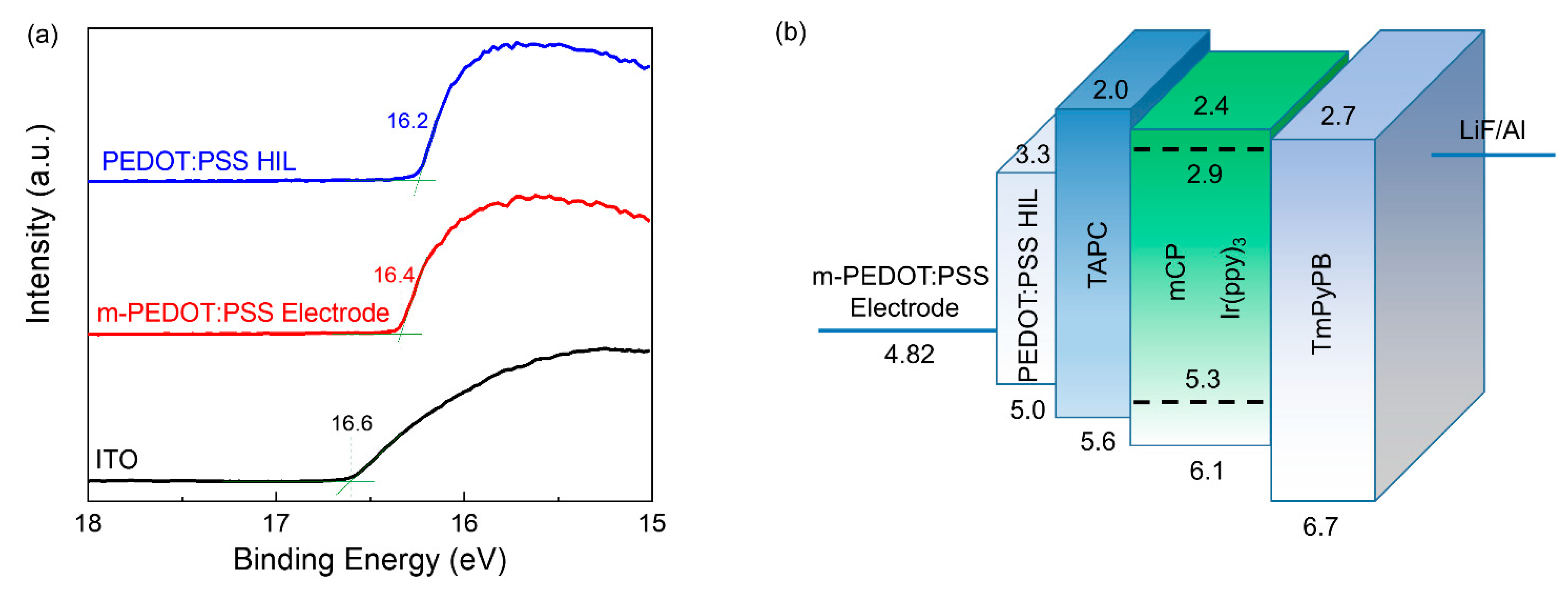

| Inks | Boiling Point (°C) | Surface Tension (mN/m) | Viscosity (cP) |
|---|---|---|---|
| EG | 197 | 48 | 20 |
| DI water | 100 | 72 | 1 |
| m-PEDOT:PSS | - | - | 44 |
| m-PEDOT:PSS:DI water (2:1) | - | - | 17 |
| m-PEDOT:PSS:EG (1:1) | - | - | 25 |
| m-PEDOT:PSS:EG:DI water (2:2:1) | - | - | 11 |
Publisher’s Note: MDPI stays neutral with regard to jurisdictional claims in published maps and institutional affiliations. |
© 2021 by the authors. Licensee MDPI, Basel, Switzerland. This article is an open access article distributed under the terms and conditions of the Creative Commons Attribution (CC BY) license (https://creativecommons.org/licenses/by/4.0/).
Share and Cite
Liu, Y.; Xie, J.; Liu, L.; Fan, K.; Zhang, Z.; Chen, S.; Chen, S. Inkjet-Printed Highly Conductive Poly(3,4-ethylenedioxythiophene): Poly(styrenesulfonate) Electrode for Organic Light-Emitting Diodes. Micromachines 2021, 12, 889. https://doi.org/10.3390/mi12080889
Liu Y, Xie J, Liu L, Fan K, Zhang Z, Chen S, Chen S. Inkjet-Printed Highly Conductive Poly(3,4-ethylenedioxythiophene): Poly(styrenesulfonate) Electrode for Organic Light-Emitting Diodes. Micromachines. 2021; 12(8):889. https://doi.org/10.3390/mi12080889
Chicago/Turabian StyleLiu, Yadong, Juxuan Xie, Lihui Liu, Kai Fan, Zixuan Zhang, Shiyan Chen, and Shufen Chen. 2021. "Inkjet-Printed Highly Conductive Poly(3,4-ethylenedioxythiophene): Poly(styrenesulfonate) Electrode for Organic Light-Emitting Diodes" Micromachines 12, no. 8: 889. https://doi.org/10.3390/mi12080889




